Control, precision & flow
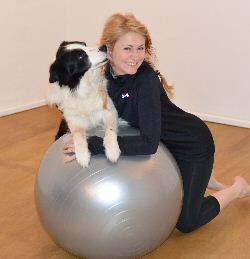 In
general dogs react faster to physical signals than verbal commands so, from time to time, we
can send out a signal before we can utter the verbal cue. When we get it wrong, it goes very
wrong. That's why it is important to make sure that our body language is accurate as possible.
Pilates and dance instructor Stacy Weeks explains how dog agility and Pilates complement each
other and how we can use this body mind programme system as an extra arsenal in our tool kit
this season If you would like to know more about Pilates and the postural perspective on dog agility, read
on... In
general dogs react faster to physical signals than verbal commands so, from time to time, we
can send out a signal before we can utter the verbal cue. When we get it wrong, it goes very
wrong. That's why it is important to make sure that our body language is accurate as possible.
Pilates and dance instructor Stacy Weeks explains how dog agility and Pilates complement each
other and how we can use this body mind programme system as an extra arsenal in our tool kit
this season If you would like to know more about Pilates and the postural perspective on dog agility, read
on...
In
2008, having spent a year in a barn watching my husband have fun with our Staffordshire Bull
Terrier X, I got my first Border Collie. Growing up, we'd always had adorable rescue so I
didn't know what I was looking for. Watching the Border Collies move at training,
it was their grace and athleticism that struck me the most. I'd always liked them and, as
a child I'd had a play farm with sheep and a sheep dog. In fact, I still have that sheep dog model in my
office!.
Collies captivated me with their beauty and movement and that was it. I had to
have one, so that's when Chace (Brueway Chasing Dreams) came into my life. He's my 'heart' dog,
totally devoted to me and willing to work all day, if he could. We're currently only Grade 2
(and a third) so I don't profess to know everything about dog agility, but I do know about
movement, stability and the body. I noticed a massive difference in my handling at the end of
last season. We had achieved more than we had ever done before. A lot of that was due to some
1:1 training but my body felt stronger than ever, too.
What's all this got to do with Pilates?
As a trained dancer and Pilates instructor, I'm fascinated with bodies, movement and
relationships. Dog agility has it all - a relationship between dog and handler, positioning
both body and dog to move efficiently around the course. However, until very recently, I hadn't
given a thought to how similar the principles of Pilates were to the mental and physical
elements required for dog agility and competition.
We all look at the top handlers in awe,
with their precision, control and flow, and that's exactly three of the core principles engaged when
we practice Pilates. The main principles are-
-
Breath
-
Co-ordination
-
Concentration
-
Centering
-
Control
-
Flow
-
Precision
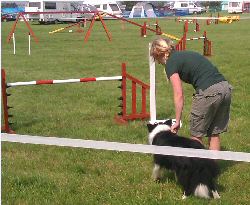 There are more, but traditionally these are,
what I term, the magic seven. All of these can be applied to the
way we work with our dogs in the ring. Centering, for example, is about recognising and
focussing on the inside of the body, making a body/mind connection. By focussing before we set
off, we make sure we stay centred throughout the run. Next time you are in the ring, walking
away from your dog, take that moment to centre yourself before you start. You may be less
likely to panic or let the pressure get to you. I was forever being told to breath before I
started running Chace. I wasn't applying my own medicine, or those of the master, so to speak. ‘Above
all learn how to breath correctly' (Joseph Pilates) There are more, but traditionally these are,
what I term, the magic seven. All of these can be applied to the
way we work with our dogs in the ring. Centering, for example, is about recognising and
focussing on the inside of the body, making a body/mind connection. By focussing before we set
off, we make sure we stay centred throughout the run. Next time you are in the ring, walking
away from your dog, take that moment to centre yourself before you start. You may be less
likely to panic or let the pressure get to you. I was forever being told to breath before I
started running Chace. I wasn't applying my own medicine, or those of the master, so to speak. ‘Above
all learn how to breath correctly' (Joseph Pilates)
Pilates is a personal journey not a competition.
Pilates was originally called Contrology, a proper and long
term practice that enables you to have total control over body and mind in everything that you do
for the rest of your life.
‘Contrology is designed to give you suppleness, natural grace
and skill that will be unmistakeably reflected in the way you walk, play and work' (Joseph Pilates).
It's a long term programme and you don't have to be flexible or in your 20's to do it. Joseph
Pilates puts it so well ‘ A man is only as
young as his spinal column'. That's why I
love it!
Taught correctly in the right environment you really do see and feel the
difference no matter how old you are. Many of us work during the week and compete at weekends
and in our holidays. We come from all types of backgrounds and span the ages more than many
other sports, so we all tend to come into (become addicted to) dog agility from a hobbyist
perspective. For that reason alone, it is important to look after ourselves. We need
to maintain our bodies as much as the pro's.
Dog agility is rapidly progressing. There are lots
of people starting to focus on the competitor as well as the dog, more so now than ever. This
both excites and concerns me, I see pictures of camps where people are enjoying themselves
getting fit which is great but I also see people doing exercises that they are just not ready
to do or in bad positioning. There are some great fitness coaches out there but some have a one
size fits all approach, I personally believe this method does not work. We are graded in the
ring for a reason so the same applies to our physical selves; you wouldn't do the London
Marathon if you had never run more than half a mile before would you?
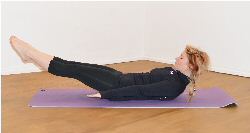 Physical
fitness training, in basic terms, is about how the body works i.e. what you want it to do and what
muscles are required to support that movement. However, I also need to know what is going on
with each of the bodies that will be doing all of that so I can make it safe and effective. I
want to make sure I give my clients exercises right for their type, level of fitness, posture
and the activity they want to do. Physical
fitness training, in basic terms, is about how the body works i.e. what you want it to do and what
muscles are required to support that movement. However, I also need to know what is going on
with each of the bodies that will be doing all of that so I can make it safe and effective. I
want to make sure I give my clients exercises right for their type, level of fitness, posture
and the activity they want to do.
Even a group class has individual progressions and
regressions per client. Pilates works on stabilising weakness. Learning how to isolate those
internal muscles, makes people stronger so their body works more efficiently. For example,
lots of the new European handling is requiring our bodies to twist faster than before so whole
core control - not just abdominals - is highly important.
To be better handlers, we need to give our dogs more
co-ordinated and precise signals, and that's what we are seeing from some of the top handlers. Sit
ups and crunches are okay, but classical Pilates exercises like the
Hundred (above), Roll Up, Criss Cross and Leg Pull Back Prone
all focus on the internal support systems, the local muscles like transverse abdominis, internal obliques, multifidus and pelvic floor. In Pilates, we isolate
these muscle groups using positioning called neutral spine, the position of the spine required
for optimum execution of exercises. The precision and posture correction gained from working
those internal stabilisers could really help us all give our dog's better physical
communication.
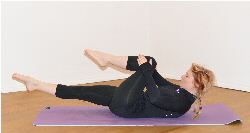 Pilates also works the body uniformly and doesn't bulk you up.
Lots of the exercises use and work on improving coordination, meaning that when your legs are
moving this may not be the main focus of the exercise. For instance,
Single Leg Stretch (left),
a good one for hamstring and hip flexor length and pelvic stability, requires you to move the
legs whilst doing specific breath patterning, but the focus is on maintaining and keeping the
pelvis stationary. Pilates also works the body uniformly and doesn't bulk you up.
Lots of the exercises use and work on improving coordination, meaning that when your legs are
moving this may not be the main focus of the exercise. For instance,
Single Leg Stretch (left),
a good one for hamstring and hip flexor length and pelvic stability, requires you to move the
legs whilst doing specific breath patterning, but the focus is on maintaining and keeping the
pelvis stationary.
‘Good posture can be successfully acquired
only when the entire mechanism of the body is under perfect control'(Joseph Pilates)
Posture is the most necessary ingredient for movement. In order
to move freely in optimum performance, your body can only work at its best in its perfect
position and a whole number of factors can alter your posture. Your posture type speaks volumes
about your choice of career, lifestyle, emotional state and physicality.
The most common
posture type I have walk into my studio is the kypho-lordotic posture type. It's a mixture of
the lower and upper cross syndromes relating to scapular and thoracic positioning and lumbar
and pelvic/sacral positioning. In short, it means that you have rounded shoulders (kyphosis) and
a more pronounced curve in your lower back area (lordosis). A combination of this usually means
that the chest and lower back are tight and abdominals and upper back are weak. These muscles
are vital for supporting the body in movement.
The kypho-lordotic posture type is mostly
associated with sedentary lifestyles or those who have to sit at a desk for long periods of
time. Let's face it, not all of us are lucky enough to be working in the dog world. Have a
little look in the mirror when you are getting dressed. Don't adjust your posture; really look
at what you have to work with. Do your shoulders fall forward? Can you see the back of your
hands? When you turn to the side does your lower back have a slight ski jump and your belly
stick out? Most importantly do you look even? Look at shoulder, hip, knee and ankle height. Try
pulling in your tummy and standing tall. Instantly you look taller, slimmer and more confident.
%20Heidi%20Vague%20(KC%20&%20UKA%20Judge,%20G3%20&%20G6)%20) Applying
Pilates to agility Applying
Pilates to agility
Over the last four months Mid Cornwall Dog Training Club (MCDTC) have taken up the Pilates
challenge and some members have been attending a group class at my studio in St. Austell,
Cornwall (Red Yew Studio). We have been looking at the effort needed in the ring, the movement
we need to train for and stabilising their bodies all in relation to their own goals and physicalities.
There are a mixture of posture types and ages in the class, ranging in age from early 30s to late
70s and from Grade 1 to Grade 7. Many of them had the kypho-lordotic posture type
I mentioned above, or they either had just kyphosis or lordosis. We've
been working on different stabilising exercises for specific movements. A front cross, for
example, requires twisting. The obliques need to be strong to support this action so exercises
like ‘Cosack' warm the body for the main phase Intrmediate exercise ‘Criss Cross'.
We also do
some upper body strengthening supplementary to the traditional Pilates, stretches for the ring
and look at self myofascial release (self-massage) using foam rollers, spiky balls, tennis
balls and Kong's™. What has been great to
see in this group is the growth in confidence as the postures and strength changes. They have
all added at least 40 seconds to their initial plank assessment times - one tripling it! 90% of
the people in the class
have noticed a change to their ability to run and/or improved mobility the next day. All of them
are feeling stronger and can see a difference in their bodies and, so far, most of them have been
placed in the top four at the local winter matches!
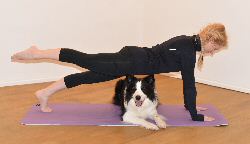 Joseph Pilates didn't believe that his system was something to
be practiced once a week. He meant for it to become an unconscious automatic behaviour that
transcribes into life outside of the studio. His method and principles can be applied to
everything we do - from baking a cake, pushing a shopping trolley or running our dogs in the
ring. Joseph Pilates didn't believe that his system was something to
be practiced once a week. He meant for it to become an unconscious automatic behaviour that
transcribes into life outside of the studio. His method and principles can be applied to
everything we do - from baking a cake, pushing a shopping trolley or running our dogs in the
ring.
When practiced, Joseph Pilates exercises and principles give us an awareness of our
bodies like no other, and that's what the MCDTC group have noticed. They are more aware of
their bodies and more confident to move and are applying those methods both inside and outside
the ring. When the body is stable and strong, we can perform better. It eliminates the need for
the body to cheat to achieve.
We teach our dogs to balance in 'prettys' and stand on wobble
cushions. We ask them to control themselves round noodles or precise tight turns and to
concentrate and focus whilst following our verbal and physical commands. We
train our canine partners to have that control, precision and flow, so surely a good
partnership requires the whole team to be doing the same. What I'm trying to say is that we
need to look after ourselves as well as our dogs. Good core control gives us the ability to
give better direction and less chance for physical command errors. Do we not owe it to them to
be just as good as we expect them to be?
 Thanks for reading. Want to chat further about this article or
arrange a consultation for yourself or your club, email me on
perspective@redyew.co.uk
or visit my website
www.redyew.co.uk Thanks for reading. Want to chat further about this article or
arrange a consultation for yourself or your club, email me on
perspective@redyew.co.uk
or visit my website
www.redyew.co.uk
If
this article has inspired you to take up Pilates, here's a great article to help you know what
to look for in an instructor:
http://www.examiner.com/article/how-to-determine-if-you-have-agood-
pilates-instructor
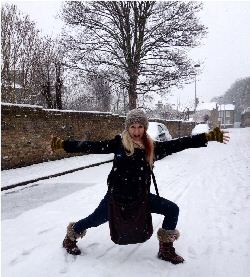 About the author... About the author...
Stacy Weeks is a Committee member of Mid
Cornwall DTC, a member of Cornwall AC and is currently putting Lauren Langman and some of the
Devon Dogs / Absolute DOGS team through their paces. She also trains with Graham Partridge and
Lauren Langman.
Stacy has a diploma in traditional
Pilates method and is founder/owner of Red Yew Studio. Her classes have been featured in National Geographic Traveller (2012), The Independent (2012) and
My Cornwall (2013). Stacy also teaches bare foot balance training called BeamFit™ and runs
dance classes for children. Her classes in Pilates are all held at her own studio in St. Austell,
Cornwall, where she trains her small group classes and body consultancy sessions, consisting of
1:1 coaching, postural assessments and functional biomechanics analysis.
After suffering a car accident whilst
studying dance in 2001, she turned her hand to pub management and, in 2007, she moved back home
to Cornwall with her husband. It was there that they took up dog agility.
Stacy returned to university in 2010 and
completed a BA honours degree in Dance Theatre, gaining 1st class honours. Her dance film work
has won awards at film festivals, and she is currently on a sabbatical from her Masters in
research degree at Plymouth University.
Stacy used Pilates to rehabilitate herself
after her second car accident and decided to train as an instructor.
First published 27 March 2014
|